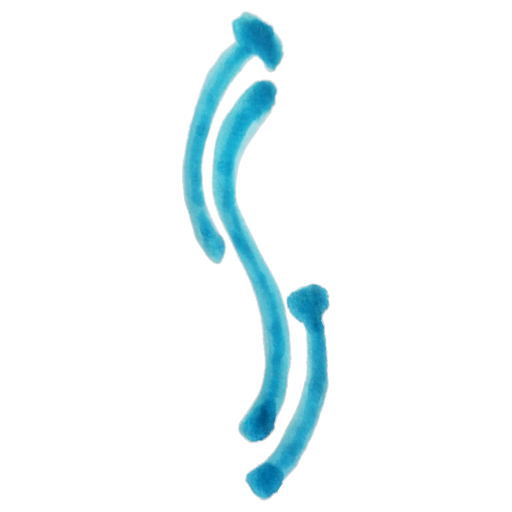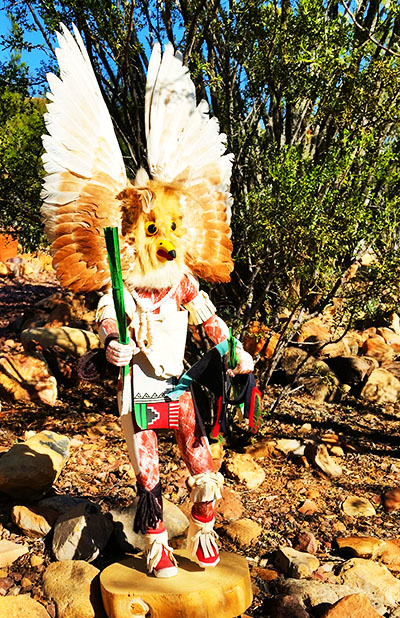Mongwa, Great Horned Owl Kachina
Mongwa, the Great Horned Owl
Hopi Great Horned Owl Kachina/Katsina, Mongwa symbolizes intelligence and wisdom. The Hopi feel the Mongwa kachina is very beneficial to agriculture keeping their fields free of rodents. Mongwa, the Great Horned Owl is also available at the village dances to knock sense into the kachina clowns.
This large Mongwa, Great Horned Owl Kachina, is one of many kachina carvings in the private collection. This MONGWA is in excellent shape with a striking rabbit skin head piece with many large upright feathers on each side, large yellow eyes, and a curved beak. As you take a closer look, you can see all the beautiful symbolic detail in the markings, ornamentation of feathers, leather, rabbit skin, necklace, shells and colorful yarn. Painted in reddish brown with white, he wears the traditional kilt with green bands and symbols folded to form a breechclout and a wide blue belt, black yarn around his wrists and right knee along with fringe and shells on the left knee and red moccasins with fringe. Mongwa carries a yucca whip.
Skillfully carved with forward body movement and bend of the arms, sharp focus of the head and bent legs as though the kachina was photographed dancing in mid-stride. Even with all the dynamic forward movement, the doll has perfect balance, standing on its own.
This kachina measures, including the base of some 2”, approximately 21” to the top of the head, and some 27” to the top of the feathers. There are no cracks or broken parts, simply excellent condition.
Feel free to contact for special shipping instructions.
What is a Kachina?
For the Hopi, a Kachina has three aspects; the supernatural being, the masked Hopi dancer and the dolls. Each Kachina has a purpose. The supernatural being is the spirit of the Hopi. Masks and decorations are worn by the Hopi dancers in the Hopi Plaza symbolizing the supernatural spirits. Kachina dolls are the teaching tools made in the likeness of the dancers of the supernatural spirit.
Kachinas represent the forces of nature, human, animal, plant, and act as intermediaries between the world of humans and the gods. They play an important part in the seasonal ceremonies of the Hopi. Kachinas represent generations of traditions that have been passed on and are the subject of a number of books.
Small kachina dolls, called tihu in Hopi, are given to children to introduce the child to what each of the kachinas look like. The dolls are carved representations of the katsinam, the spirits essences of their ancestors, animals, plants, nature, all that is within the Hopi universe.
Traditionally, kachina dolls are created by Hopi or Zuni artists, and sometimes by the Navajo.
You will see a variety of spellings for Kachina, also known as Katchinas, Katcinas, Katsinas, Kat’sina. Kachina is typically the English spelling, while Katsina is Hopi.
Starting your Kachina Collection
Starting your kachina collection is easy and fun as one can begin collecting affordably and learn the dolls. eBay or Facebook Market Place are a couple pretty good places to find affordable dolls. However, if you live in the Santa Fe or Phoenix area, for example, there are excellent museums to visit such as the Heard Museum in Phoenix. The museums are dynamic places to really learn not only about the kachinas, but also what makes for a good piece of art carving and what makes for an extraordinary carving.
Kachina dolls you find at the museums and their gift shops will be extraordinary, but don’t fret you can start out for much less. And, of course, there are many reputable Southwest Indian Arts & Crafts stores in the towns and cities of the Southwest, such as Scottsdale and Santa Fe. The best way to begin…take a road trip to the reservations in Arizona and New Mexico and talk with the artists themselves…that’s the best way!! Enjoy.


Recent Comments